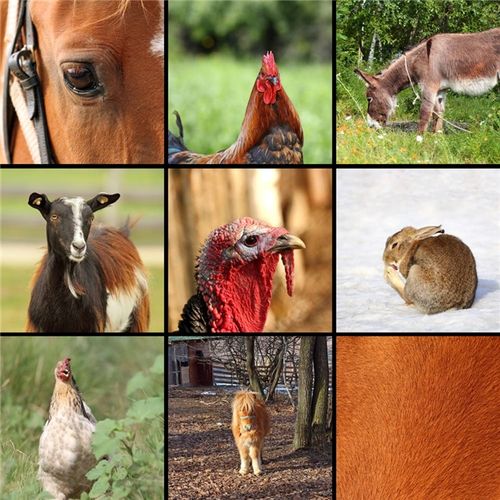Animals that eat grass, commonly known as herbivores or herbivores, are an indispensable part of the ecosystem. They mainly feed on plants, especially herbaceous plants, and play an important ecological role. This article will introduce in detail the types of herbivores, their adaptive characteristics, ecological roles, and their importance in the ecological balance.

Herbivores among mammals
Cattle (such as dairy cows and beef cattle): Cattle are a typical herbivore that mainly feeds on grass and hay. Their digestive systems are well suited to breaking down cellulose and further digesting food through the process of rumination.
Horses: Horses mainly feed on grass and hay, and have strong teeth that help them digest grass plants efficiently.
Sheep: Sheep are similar to cattle and are also typical herbivores that can adapt to a variety of grassland environments. They digest plants by constantly chewing and ruminating.
Deer (such as elk and white-tailed deer): Deer mainly feed on tender grass, leaves and fruits, and have adapted to a variety of forest and grassland environments.
Elephants: Elephants feed on a variety of plants, including grass, leaves, bark, etc. Their large size and strong teeth allow them to destroy vegetation and affect ecosystems.
Herbivores among birds
Pigeons: Pigeons feed on seeds and young leaves of plants and are able to survive widely in urban and rural environments.
Crane: Cranes feed on aquatic plants and wetland plants and are an important part of wetland ecosystems.
Herbivores among insects
Grasshoppers: Grasshoppers are common herbivorous insects in grasslands and meadows, with grass and plants as their main food source.
Caterpillars: The larval stage of many butterflies and moths is herbivorous, feeding on the leaves of various plants.
Digestive system adaptations
Ruminants: Such as cattle and sheep have a complex digestive system, including four stomach chambers, for breaking down cellulose and digesting grass plants. Their rumination behavior allows them to re-chew their food and further break it down.
Monogastros: Such as horses, have large cecums and colons for fermenting and breaking down cellulose from grass plants. Although they do not chew cud, their digestive systems have adapted to process large amounts of plant material.
Mouthparts and dentition
Grinding teeth: Herbivores usually have specialized grinding teeth for efficiently grinding plant fibers. The grinding teeth of horses and cattle are well developed and can adapt to different types of grass.
Beak and mouth structure: Some birds, such as pigeons, have hard beaks for pecking seeds and young leaves of plants.
Behavior and habits
Foraging behavior: Herbivores often have extensive foraging behavior and will adjust their food sources according to seasonal and environmental changes. For example, Elephants-Are-Endangered.html">elephants will migrate to find different plant resources.
Group living: Many herbivores live in groups to enhance their chances of survival and improve foraging efficiency.
Plant control
Herbivores help control plant growth by eating large amounts of plants, especially grasses. They prevent certain plants from over-reproducing, thus maintaining ecological balance.
Soil fertility
The feces of herbivores are important fertilizers for the soil. Their feces are rich in nutrients, which helps to improve soil fertility and promote plant growth.
Seed dispersal
Many herbivores consume seeds of plants while foraging and then spread the seeds to different places. This helps the reproduction and distribution of plants.
Ecological engineers
Habitat loss
With urbanization and agricultural expansion, the habitat of herbivores is gradually decreasing. Habitat loss poses a serious threat to the survival of herbivores.
Climate change
Climate change leads to changes in plant growth patterns, which affects the food source of herbivores. Drought and extreme weather also have a negative impact on the survival of herbivores.
Human activities
Human activities such as overgrazing, deforestation and agricultural activities directly affect the food sources and habitats of herbivores.
The following is a table showing the classification of herbivores and representative animals:
| Animal category | Representative animals | Description |
|---|---|---|
| Mammals | Cattle | Typical herbivores, mainly feeding on grass and hay. |
| Horse | Feeds mainly on grass and hay, and has a strong tooth-grinding function. | |
| Sheep | Feeds mainly on grass, has a complex digestive system and rumination behavior. | |
| Deer | Feeds on tender grass, leaves and fruits, and adapts to a variety of environments. | |
| Elephants | Feed on a variety of plants, including grass, leaves, bark, etc. | |
| Birds | Pigeons | Feed on seeds and young leaves of plants, widely distributed in cities and rural areas. |
| Crane | Feed on aquatic plants and wetland plants, and are an important part of the wetland ecosystem. | |
| Insects | Grasshoppers | Feed on grass and plants, widely distributed in grasslands and meadows. |
| Caterpillars | Larvae of butterflies and moths, mainly feed on plant leaves. | |
| Reptiles | Tortoises | Feed mainly on grass and young leaves of plants, living in dry or warm environments. |
| Fish | Grass carp | Feeds on aquatic plants and other plants, and lives primarily in freshwater environments. |
| Mammals | Camels | Feeds on grass, hay, and shrubs, and is adapted to arid environments. |
This table covers herbivores in different animal groups, including mammals, birds, insects, reptiles, and fish, showing their respective food sources and ecological adaptations.
Animals that eat grass play a vital role in ecosystems. They not only maintain the growth balance of plants, but also affect the entire ecosystem through the food chain. Understanding the adaptive characteristics of herbivores and their role in the ecosystem will help us better protect these important organisms and their habitats. At the same time, we also need to pay attention to and respond to the challenges faced by these animals to ensure the health and stability of the ecosystem.
animal tags: Herbivores
We created this article in conjunction with AI technology, then made sure it was fact-checked and edited by a Animals Top editor.